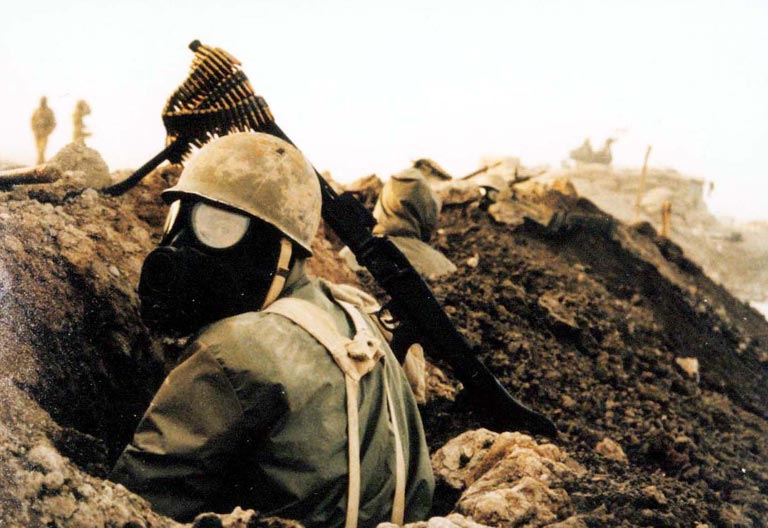
In 1979 the Islamic Revolution took place in neighboring Iran. In the 1970s there were simmering disputes over the territorial rights in the Shatt al-Arab waterway. Skirmishes had taken place. In 1975, the border between Iraq and Iran was established by a treaty, the Algiers Accord. Although Iraq was dissatisfied with the outcome of the Algiers Accord, it was powerless in light of Iran’s greater military might. The Islamic Revolution tipped the balance, however. After the downfall of Mohammad Reza Shah Pahlavi, Iranian personnel fled the country, the remaining ranks were purged, and equipment was neglected. American support, on which the Shah’s military had relied heavily, vanished overnight.
On 22 September 1980, Iraqi fighter-bombers took to the skies in an operation to take out the Iranian Air Force – a surprise attack. Iraqi mechanized columns breached the border to the east of Baghdad and, especially, in the south, where they set their sights on the cities and oil fields of Khuzestan, commonly called Arabistan in the Arab world. Baghdad was mistakenly counting on the loyalty of the Arab inhabitants of Khuzestan. In effect, no military objectives were met. The MiGs and Sukhois that reached Iranian airbases – even near the Iranian capital Tehran – succeeded in dropping bombs. However, these were unguided and incapable of penetrating the hardened aircraft shelters where the Iranian aircraft were stationed. On the very same day Iranian aircraft were able to mount retaliatory strikes.
Although better equipped and better trained, the Iraqi forces failed to generate critical mass against the Iranians, who significantly outnumbered them. This would remain so throughout the rest of the war, until the signing of a bitter cease-fire agreement in 1988.
In the first year of the war, the Iraqis dug in on a frontline not far removed from the official border. They did manage to hold a few cities, such as Khorramshar in the south. With this stalemate, both countries tried to break the opponent’s back by attacking on other fronts. First each tried to bleed the opponent dry economically by cutting off the oil exports on which both countries depended heavily. This warfront was called the Tanker War. The Iraqi effort to stop the Iranians from exporting oil was greatly helped by the arrival of French Super Etendard fighters equipped with Exocet anti-ship missiles. These had proven effective in 1982 during the Falkland War, in which the Argentine naval air force had succeeded in hitting several British vessels.
With the Iraqis successfully hitting the Iranian oil rigs and terminals such as those near Kharq Island, the Iranians sought to retaliate by targeting all tanker traffic in the Gulf. The biggest effect of the Iraqi and Iranian attacks was the astronomical surge in insurance rates for shipping in the Gulf. In 1982 a United Nations statement had condemned attacks on all commercial shipping in the region, but a more forceful international statement was put forward after the threat to the world’s oil supply increased. This was the result of innovative tactics used by the Iranians, harassing tankers with RPG and small-arms fire, but also equipping fighter aircraft with American and Soviet anti-tank missiles. The use of simple sea mines hampered the flood of oil through the Gulf.
In 1986 Kuwait asked for international assistance to protect tanker traffic. The US Navy stepped in and oil once more flowed through the Gulf unhindered. The Tanker War had failed to break the stalemate on the Iraqi-Iranian front.
War of the Cities
The Iraqi air attacks had failed to have the desired strategic effect. Moreover, the Iranian answer to the Iraqi bombing raids presented a greater threat to Iraq than vice versa. The Iraqi military had failed to appreciate an inconvenient fact: the flying distance to Tehran was much farther than to Baghdad. If Tehran were to obtain ballistic missiles such as the Russian Scud, Baghdad could be targeted. Iraqi Scuds could not, however, reach the distant Iranian capital.
Shortly afterwards, Iran did indeed obtain Scud missiles and launchers, reportedly from Libya and Syria. Given the fact that dozens of countries were equipped with Scuds, one can safely assume that Iran also bought Scuds on the black market. The Iranian missile superiority did not last for long, however. With help of, especially, German companies, the range of Iraqi Scuds was extended by fitting larger fuel tanks. With considerable success: Tehran was subsequently hit by more than 500 missiles. The throw weight of these missiles was however diminished by the extra fuel requirements. Iran launched nearly two hundred Scuds, which mostly ended up in greater Baghdad, missing the strategic targets.
The stalemate on the ground lasted. This is not to say that the Iranians did not achieve some tactical successes, especially in the marshes in the south of the country. In 1986 they launched a surprise attack on the Faw Peninsula, using it to launch anti-shipping strikes. The Iraqi army counter-attacked but could not easily dislodge the Iranian forces.
In 1988 the Iraq hit Iran with massive force, supported by gas attacks. Iranian forces withdrew. Later that year, an armistice was signed.

